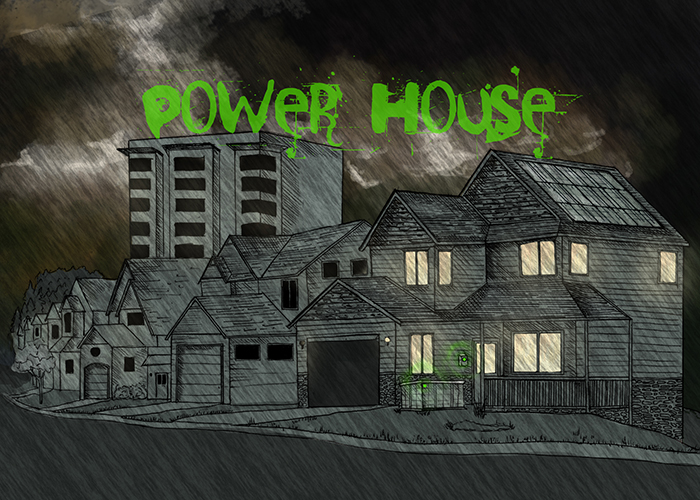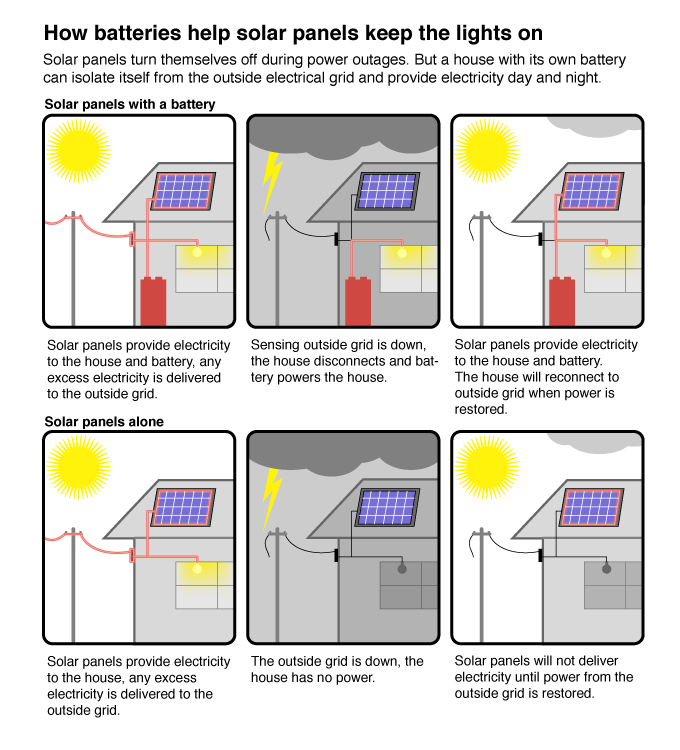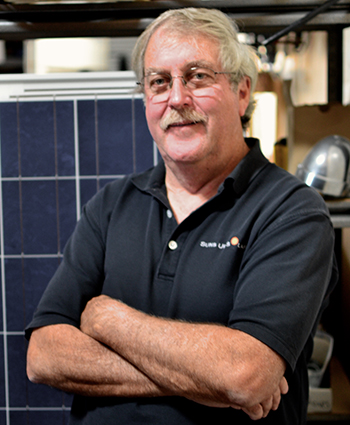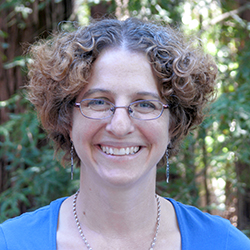
|
| Illustration: Brooke Weiland |
Our electric grid wasn’t designed to handle rooftop solar panels. Kim Smuga-Otto shows how simple microgrids can help. Illustrated by Brooke Weiland.
Along a mountain road in Santa Cruz County, one in every ten houses sports solar panels. Peter Putt of Suns Up Solar pulls his truck into the driveway of a home with a major installation. Three of the system's 38 panels perch on the sloping roof of the two-car garage. Inside is a gray minivan, a cluster of bikes, and a low white box tucked against the wall. It looks like an extra freezer.
Putt, middle-aged with gray hair and a bushy mustache, greets his client, Teresa Mangelsen, with a hug. They discuss the two fuse boxes next to the garage door opener. Then, Putt pops open the white box. It contains not frozen food, but two rows of eight black cubes, each the size of a toaster. Fat red and black cables snake among them.
“Batteries in a big tub,” Putt explains. He then points to a yellow box mounted on the wall: a switch that redirects solar power to the batteries, keeping them charged. Trees toppled by winter storms can cut power to this community for more than a day. But when this switch senses the outside electrical grid is down, it isolates the wiring and the house becomes its own supplier and consumer. The refrigerator, microwave and lights all draw power from the batteries—or directly from the sun.
The isolation switch is critical. Neighboring solar-equipped houses don't have one, so they can’t light up if the power's out. Without that switch, their electricity would flow outward into a set of downed wires, posing grave risks.
More fundamentally, the grid wasn’t designed for a multitude of small energy producers. When the U.S. invested in an alternating current grid more than a century ago, power generators were large, noisy and smelly. You wouldn’t want one in your neighborhood—much less on top of your house.
“Our grid technology? We’re living in the stone age,” says Putt.
That’s not much of an exaggeration, says Steven Greenlee, spokesperson for the grid operators of the non-profit California Independent System Operators (ISO). “[The grid] hasn't changed for a hundred years,” he says. “We built these big power plants, and we sent the electricity out in one direction for it to be consumed.”
But now, changes are coming. According to the Solar Energy Industries Association, new solar panel installations have risen sharply each of the past three years in California. About 24 percent of the electricity overseen by the California ISO now comes from renewable sources; of that amount, 37 percent comes from solar and 39 percent from wind. All of this new variable energy is forcing grid operators to adapt.
Greenlee and his colleagues oversee the grid of long-distance, high-voltage wires that transmit electricity from power plants to towns and cities. Putt connects his clients to the local distribution grid. And on the Mangelsens' property is a third grid. It manages power generation and consumption in one location. In industry parlance, it’s a microgrid.
A microgrid in every house, or even one managing each neighborhood, might tax our stressed electrical grid. However, if battery packs for houses become affordable, this bottom-up approach could end up helping utility companies and grid operators. A “smart” microgrid on a single house could monitor the house’s electrical consumption as well as its production. By communicating with the larger grid, it would know when to switch to battery power to reduce stress on the grid at peak times, saving the homeowners money on their bills.
Will utility companies embrace this new independence? When small-scale solar exceeds a critical mass in California and other states, they may not have a choice.
Grid re-education
Every afternoon, power producers come to California’s wholesale energy market to sell their goods for the next day. Suppliers of electricity from hydroelectric, natural gas and nuclear sources mingle virtually with those from solar, wind, geothermal and other renewables. The word “green” doesn't arise. “Electricity is not color-coded,” explains Greenlee. “It's all electrons.”
The rules, regulations and legal obligations governing these transactions are fiendishly complex, but the result is straightforward. Utilities—the ones that send you your monthly electric bill—buy the energy they think they’ll need tomorrow from a mix of power plants. Grid operators make sure this electricity flows through the right long-distance wires at the right times.
When the power approaches its designated community, a series of substations cranks it down to a manageable voltage. Then the utility takes over, distributing it to factories, businesses and houses. The final step occurs along the wire to each house’s meter. Like the water behind a closed faucet, the electricity sits until someone flips a switch. It then flows in to sustain our modern lifestyle.
These two grids, long-range transmission and local distribution, have been refined and optimized since George Westinghouse began wiring the country in 1885. Homes and businesses were energy consumers; that was the tenet. Then, rooftop solar panels started feeding power into the grid. Solar electricity that a house doesn’t need flows back onto the local grid to the nearest neighbor who does need it. Legislation mandated that homeowners be paid for these contributions. Now, part of hooking up solar panels is adapting the house meter so it records electricity going out as well as coming in.
This new energy production all happens on the distribution grid—and it’s adding up. From California rooftop solar arrays alone, says Greenlee, “it’s [now] about 2,400 megawatts of energy that is beyond our vision.” That’s like ten average power plants operating without oversight.
Bur unlike the known output from power plants, power from the sun isn't steady; it ebbs and flows. Much of that is predictable: The rising and setting of the sun holds no surprises, and meteorologists are increasingly better at forecasting sunny days. But challenges arise on windy and partly cloudy days when the sun pops in and out, says engineer David Schoenwald of Sandia National Laboratories in New Mexico, who studies grid stability. “The amount of power [produced by panels] will drop, then rise, rapidly fluctuating within a matter of seconds,” he says.
This doesn’t yet pose a serious problem, says Schoenwald. “No one notices those changes, because photovoltaic penetration is still very small”—just 1 to 2 percent of the total power on most distribution grids. But if small solar installations contribute 15 to 20 percent of a given grid’s energy, he notes, these fluctuations would have a major impact. In any given neighborhood, like the road in the Santa Cruz Mountains with its sprinkling of rooftop arrays, it’s hard to pinpoint how much electricity comes from solar and how much from the utility. It's clear the solar proportion is rising.
 |
| Graphic: Kim Smuga-Otto |
|
Linking solar panels to batteries would smooth out these sun-driven fluctuations. By charging and discharging, batteries can absorb energy spikes and supplement energy dips. Large batteries don’t need to be installed at the distribution grid level; small batteries on many house microgrids could have the same effect.
Power stores
Microgrids are excellent test beds to explore the interactions between renewable energy and batteries. A team of UC Santa Cruz engineers and students created a 25-kilowatt microgrid at the NASA Ames Research Center that incorporates a battery on wheels: an electric car.
The team was inspired by a 2008 exchange program in Lolland, one of Denmark’s large Baltic Sea islands. Denmark is a world leader in small energy distribution. Sources include ocean waves, bioenergy and wind turbines that sprout from the sea like dandelions gone to seed. Wind generates nearly 40 percent of Denmark’s electricity, but there’s no way to store it for a calm day. Hooking up those small generators to batteries through microgrids could be a solution.
“Batteries are hard to manage,” says UCSC electrical engineer Joel Kubby, one of the trip’s instructors. “They're heavy and they can be dirty, but as more people get electric vehicles, they'll have a big battery in their garage anyway.”
The team explored whether an electric car's battery could act as a microgrid’s sole storage device. The microgrid would have to be isolated, or “islanded,” with no capacity to divert excess electricity to the distribution grid. The battery also would need to be the right size; too much electricity would damage the car.
With only three weeks to complete their project in Lolland, the researchers modeled their system in software instead of building it. They calculated that the battery of a Prius Hybrid, with 9 kilowatt-hours of storage, was too small. They’d need something capable of storing more than 50 kilowatt-hours—like the battery of a Tesla Roadster.
Back in California, Kubby aimed for a real-world demonstration—especially if it incorporated a Tesla. He sent a proposal to the U.S. Department of Energy for a microgrid with a fleet of 20 Teslas, but it wasn’t funded. (“I think they saw through it,” he says wryly.) Instead, Kubby secured funding for a modest microgrid at NASA Ames that involves students day-to-day.
The UCSC system incorporates sensors, solar panels, a small wind turbine, a permanent 23-kilowatt-hour battery and a blue-and-yellow two-seat electric car, nicknamed eSlug. College and high school students can manipulate the angles of the solar panels remotely for their lab classes. One of Kubby’s grad students used the sensors to forecast the sun's intensity on the panels 20 minutes in advance—a possible way to even out peaks and valleys in power. And while eSlug was not the exclusive battery, the team did engineer the system to charge the car.
Employees at NASA Ames who own electric cars took note. “They're not allowed to recharge their vehicles there because [the center] is on government juice,” says Kubby, “and our juice is private.” But what started as a few employees discreetly plugging into the experiment developed into a charging schedule for their cars, based on commuting distance.
Solar panels on a home's roof and an electric car in the garage will become more common as prices drop or as federal incentives continue. But springing for a microgrid is still beyond the budgets of most customers. Batteries are expensive; Tesla CEO Elon Musk recently unveiled the Tesla Powerwall, a lithium-ion electric battery for homes, at a cost of $3,500 for a 10 kilowatt-hour system. But prices will come down—and early adopters are showing the way.
The always-on house
At the Mangelsens' home, the tub full of batteries and its accompanying switch increased the price of their solar panel system by 40 percent. “I want power because I'm generating it,” says Teresa Mangelsen, explaining her willingness to pay more. “Everybody else who has solar panels doesn't have power when the power goes out.”
 |
Animation: Brooke Weiland |
| A house with solar panels and its own battery—a "microgrid"—can run on its own power when the rest of the neighborhood blacks out. Click on the image to go to Vimeo animation. |
|
To keep their lights running safely when the grid is down, the Mangelsens must isolate their microgrid from the neighborhood lines. Otherwise, their unused solar electricity would escape to a power line that’s supposed to be dead. “There’s going to be some poor guy up on a pole who'll be electrocuted because everyone is pushing power into their wires,” says Putt.
Such safety concerns justify the utility’s on-site inspection of each new solar panel installation to make sure no uncontrolled “backflows” occur. Usually, approval takes about 10 days. However, the Mangelsens waited four months for their utility, Pacific Gas and Electric, to hook up their microgrid to the distribution grid. PG&E tacked on an $800 grid safety fee, later refunded, and demanded fees for the battery and for upgrading a street transformer.
Putt has a theory about what was going on: “[PG&E] was worried we were going to set [the batteries] up to draw cheap energy at night and run them dry during the peak daytime hours.” In other words, at typical night-day rates, the Mangelsens could buy electricity at 15 cents per kilowatt-hour and sell it back at 44 cents. Although the Mangelsens' system is not configured to do that, Putt says it is smart enough to do so.
 |
Photo: Kim Smuga-Otto |
| Peter Putt of Suns Up Solar. |
|
If home batteries proliferate, it will pose both a challenge and an opportunity to PG&E. California is requiring the utility to add more than 400 megawatt-hours of storage to the grid by 2024. Some of this stored energy could be sold on the marketplace under the watch of grid operators. Spare kilowatt-hours from the Mangelsens and other wired homes aren’t yet worth buying. But excess electricity storage from a larger community could reach megawatt-hours—enough to help the grid meet peak energy demands.
To take advantage of this potential revenue, entrepreneurs need microgrids that can monitor their own energy usage and communicate with the outside grid. They need smart microgrids.
The home electric lab
An ideal smart microgrid would be a miniature version of the grid operators’ control room. Just as the operators match energy supply to demand hour by hour, the smart house microgrid would monitor the energy needs of all your active appliances. If supply dipped, or the larger grid needed customers to cut back, the microgrid would order your appliances to lower their electrical draws—or to turn themselves off.
Companies already sell this custom technology to high-end clients. But electrical and systems engineer Pat Mantey of UC Santa Cruz thinks the prices are absurd. “Who’s going to pay $30,000 to instrument their house to manage their electric load when they’re only paying a few thousand a year for electricity?” he asks. A reasonable price for such a system, Mantey feels, would be under $500.
In his search to design an affordable solution, Mantey sought a real-world test setting. With my wife's acquiescence, if not total enthusiasm,” he says, “I’ve turned my house into a part of the lab.”
Mantey built his house 34 years ago near the summit of the Santa Cruz Mountains in Scotts Valley. He designed lots of windows with southern exposure for passive solar heating. In the 1980s, he added a solar water heater on his roof. He held off on solar panels until tax breaks made them affordable about seven years ago. Now he gets five-and-a-half kilowatts on sunny days, more than he usually uses. Next on his to-do list: hook up batteries so his house can weather outages exclusively on his green power. But he’s less interested in how his house makes electricity than how it uses it.
The smart meter installed with his solar panels measures his whole house’s usage in 15-minute chunks that Mantey collects with a receiver to sends to his website for analysis. But the 15-minute window is too broad to find the data he seeks. “I ask my students, ‘Can you guys see where my refrigerator defrosted?’ No, you can’t find it,” he says.
Podcast produced by Kim Smuga-Otto. Click on image to play
Recently, a refrigerator failure made Mantey consider what kind of electrical signal a failing compressor would make, and how he would detect it. He and his students came up with their device called “Smart Energy Analysis and Disaggregation,” which can monitor an electrical circuit 1,000 times every second. Each appliance makes its own "footprint" of voltage and current that the detector can perceive, even with many devices running at once.
Besides keeping track of weird power surges that could predict a malfunctioning appliance, the information could decrease the house’s energy usage during peak demand on the main grid. In an incentive program now run by PG&E, the utility can remotely turn off a customer’s central air conditioning on particularly hot days when overall demand is extremely high. With Mantey’s smart microgrid, the customer could shut down any particular device in response to high demand—or the system could do it automatically.
Home batteries, isolated microgrids, and smart power monitoring are all parts of a grassroots approach that may improve our grid infrastructure from the bottom up. But Mantey's home laboratory shows how much work it will take to make these tools commonplace. “I’m most of the smarts,” he admits. “When I leave town for a week and the house runs like it does when I’m home, I think it’s getting reasonably smart. When it runs better than I can do it, then I’ll call it smart.”
© 2015 Kim Smuga-Otto / UC Santa Cruz Science Communication Program
Top
Biographies
 Kim Smuga-Otto Kim Smuga-Otto
B.A. (bacteriology) University of Wisconsin, Madison
Internship: Stanford University School of Medicine
In 2007, I learned a magic trick. With a defective virus and a handful of genes, I transformed scrawny, exhausted skin cells into flourishing cell clusters. Tinkering with the nutrient broth could morph them into spiky neurons, beating heart muscles, or any tissue in our bodies.
My lab had uncovered a new source for stem cells. This being science, not magic, we eagerly revealed our secret to the world. For the briefest of moments, everyone—including my family—was genuinely interested in what I did.
To explain the steps and missteps that led to the Big Wow, I worked a different magic. I transformed an abstract discovery into a narrative that helped my audience understand the science and connect with the scientists behind it. That’s a trick I want to master as a science writer.
Kim Smuga-Otto's website
. . . . . . . . . . . . . . . . . . . . . . . . . . . . . . . . . . . . . . . . . . . . . . . . . . .
 Brooke Weiland Brooke Weiland
B.A. (environmental studies and evolutionary biology) University of Wisconsin, Madison
Internship: Canyonlands Research Center, Utah
Science advances most quickly with collaboration and communication. Empowering the public by providing the knowledge required to engage in open and informed scientific dialogue is a critical. I believe illustration is instrumental in achieving this goal. I am dedicated to science, nature, and art throughout all of my work.
Brooke Weiland's website
Top |

